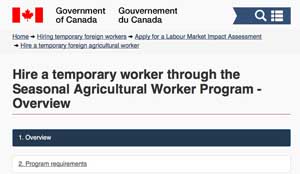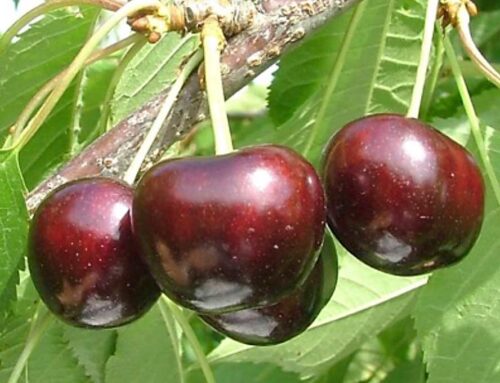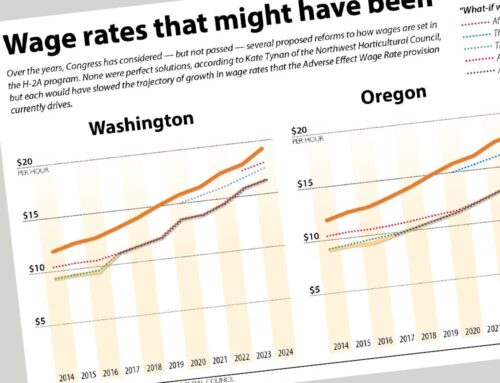A program supplying seasonal workers to Canadian farmers is necessary to the survival of agriculture in Ontario, according to a new study released by Agri-Food Economic Systems, an economic research firm based in Guelph, Ontario.

Canadian temporary worker website.
Celebrating its 50th anniversary this year, the Seasonal Agricultural Workers Program (SAWP) brings more than 30,000 guest workers to Canada annually, with 17,500 working in Ontario.
“Their labor creates $5.4 billion in economic activity and 34,280 additional agricultural sector jobs,” said Ken Forth, a Hamilton, Ontario, vegetable grower and president of the Foreign Agricultural Resource Management Services (FARMS).
Despite SAWP being a federal program, FARMS has administered it since 1985, when the Canadian government handed the responsibility for running it to the farmers who benefit from the program.
History
Following World War II, the Hamilton/Niagara area of Ontario experienced a huge influx of immigrants from Italy, Portugal and Eastern Europe. The men went to work at one of the large steel mills then in the region, and their wives went to work in the fields.
Seasonal laborers were plentiful.
“My grandfather used to say you only wanted to take a vehicle with space for the number of workers you wanted and nothing more or you’d get too many,” Forth said.
The immigrants came to the region with nothing, but as time passed, they eventually made enough money to buy houses and improve their lifestyles. “All of a sudden, in the mid-1960s, all these guys started saying, ‘My wife, she’s not working any more,’” he said.
By then, immigration to that part of the country had all but stopped. There were no new immigrants to take their places and little interest from local Canadians to do that kind of work.
The Canadian government launched a pilot guest worker program in 1966, bringing in 264 men from Jamaica. It was a timely decision because by the mid-1970s, all the original immigrant labor had retired.
“They created a bilateral program,” Forth said. “The Canadian government and the governments of the countries where the labor came from, as well as the farm community, were all involved in running the program.”
In 1985, the Canadian government came to the farmers and said the $250,000 they spent each year to run the program made it too expensive. “We said, ‘You can’t close it down! It’s too necessary!’ They said, ‘Then you run it,’” he said.
So, the farmers set up a nonprofit corporation to run the program. The federal government retained the right to refuse service to any growers whose operation does not meet SAWP standards.
Today
Workers arrive throughout the year, but no worker can stay longer than eight months.
Forth has used the program to hire seasonal workers on his 250-acre farm for 46 years. He and his son hire 18 Jamaican workers, plus two or three local Canadians to work on their operation. One Jamaican worker has worked for them for 31 years.
Keeping workers around for that many years is not uncommon on Canadian farms. Hector Delanghe said returning workers comprise 95 percent of his seasonal help.
Delanghe has a 400-acre farm, 200 acres of which is in fruit. He grows apples, peaches, pears, plums, apricots, nectarines and strawberries in Blenheim, Ontario. Delanghe said he hires about 20 guest workers each year and has used the program for 47 years. “If we get more local help, then we won’t bring in as many foreign workers,” he said.
All of his workers are trained to run the farm machinery. Two are trained assistants, workers who are licensed to apply chemicals on the farm. The rest of the crews “do a lot of pruning, thinning and harvest work.”
Massive shortage
The U.S. guest worker program, H-2A, has come under criticism from farm labor groups who contend the program takes jobs from domestic laborers. That kind of criticism exists in Canada, too, coming mainly from advocacy groups and unions, even though Ontario law forbids the unionization of farm labor.
However, the criticism is muted somewhat by research showing large agricultural labor shortages there.
A recent study by the Conference Board of Canada, an independent, nonprofit applied research organization, showed that Canadian agriculture had positions for 59,000 seasonal workers. “We were able to fill 43,000 jobs with foreign workers, leaving 16,000 jobs unfilled,” Forth said.
By 2025, he said, the study projected Canadian agriculture would be short 114,000 jobs. •
– by Dave Weinstock
Correction: May 11, 2016
This story was published with the name of grower Ken Forth, as Ken Force. Good Fruit Grower magazine regrets the error.






Leave A Comment